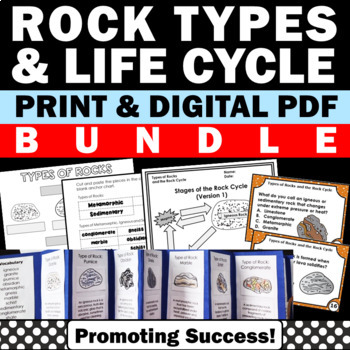15 Rock Cycle STEM Activities Your Students Will Actually Remember
Hands-on geology projects for grades 4 –6 and beyond
Are you looking for creative, hands-on ways to teach the rock cycle? Whether you're in a 4th grade classroom, a 5th grade science lab, or supporting middle school learners, these rock cycle STEM activities will help your students truly understand how rocks transform—from sedimentary to metamorphic to igneous—and back again.
Before you dive in, grab this FREE Rock Cycle Word Search to introduce or review vocabulary with zero prep!
15 Rock Cycle Activities That Make Science Stick
These projects combine science, art, engineering, technology, and writing to reach a variety of learning styles. Plus, they’re easy to differentiate by grade level or ability.1. Rock Cycle Models
Use clay, paper mache, or natural materials to model how rocks change from one type to another. Bonus points for labeling and creativity!2. Igneous Rock Identification
Provide a variety of igneous rock samples and let students explore texture, color, and mineral content. Create a class bulletin board to display their findings.
3. Sedimentary Rock Formation
Use sand, gravel, and clay to show how layers form over time. Let students test their "rocks" for hardness and water absorption.
4. Metamorphic Rock Heat + Pressure Experiment
Use wax paper, crayons, or chocolate chips to demonstrate how heat and pressure can physically change substances—just like real metamorphic rocks!
Have students explain the cycle in their own words using animation, drawings, or even claymation. Great for tech integration and language skills.
6. Design a Rock Cycle Board Game
Students can review vocabulary and concepts by designing their own trivia-style games with rock cycle “challenges” and stages.
Use Google Earth or online videos to “visit” famous rock formations like the Grand Canyon or Giant’s Causeway.
8. Rock Cycle Art: Paint the Process
Turn science into art with a painting project. Have students blend colors to represent transitions between rock types.
9. Virtual Lab
Let students test their knowledge with online simulations that show how rocks evolve over time.
10. Sculpt It!
Challenge students to build a sculpture representing one part of the rock cycle using cardboard, foil, or recycled materials.
Ask students to write a short story or comic from a rock’s point of view as it travels through the rock cycle.
12. Sorting & Classifying Rocks
Set up a hands-on station where students classify rocks by type, color, luster, and texture.
13. Make a Music Video
Yes, really! Let your students write a rap or pop-style song about the rock cycle—and record it for science fame!
Hide rocks around the school or playground labeled with different rock cycle stages. Give clues and GPS coordinates for a mini geology scavenger hunt.
15. Build a DIY Rock Tumbler
For your most advanced tinkerers, challenge them to design a basic rock tumbler and simulate natural erosion and polishing.
Keep the Learning Going
If you want more ready-to-go science activities, don’t miss these classroom favorites:

Rocks and Minerals Bundle of Activities
And if you’re building your science resources, don’t miss my curated list of educational science kits on Amazon to add extra hands-on experiences to your classroom. Click HERE.
Please feel free to message me with any requests or comments.
Thank you so much!
❤️ Shelly Anton
Promoting Success for You and Your Students!
https://www.teacherspayteachers.com/Store/Promoting-Success
Shelly Anton is a participant in the Amazon Services LLC Associates Program, an affiliate advertising program designed to provide a means for sites to earn advertising fees by advertising and linking to Amazon.com. ** This means there are Amazon affiliate links in these blog posts. This does not mean you pay a dime more when you purchase a product through the link. It just means I am trying to save you valuable teacher time by making it easier for you to find valuable resources for your students, and I earn a few cents for my research and time. Thank you for all you do for kids!



.png)









No comments:
Post a Comment
Please leave a comment below. Thank you!